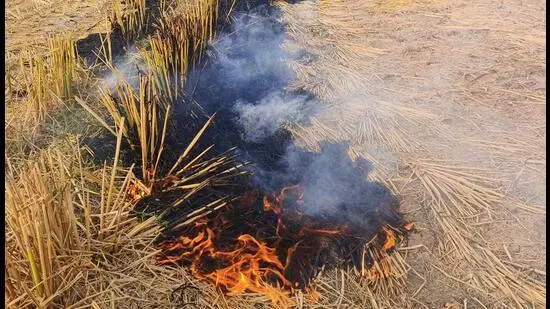
The Decision Support System (DSS), the only source apportionment study currently available to identify sources contributing to Delhi’s PM 2.5 pollution, has been failing to accurately forecast the impact of stubble burning in the Capital this season, officials have said.
In recent days, DSS forecasts projected that stubble burning could contribute over 30% to Delhi’s PM 2.5 levels. However, actual contributions have remained below 10% on all days, based on fire counts recorded later in the day.
The DSS operates under the Ministry of Earth Sciences and is managed by the Indian Institute of Tropical Meteorology (IITM) in Pune. Officials said that this year, the pattern of stubble burning has changed compared to previous seasons, which may have led to inaccuracies in the model’s projections.
“The biomass burning estimates for the next day are based on the fire count detected by the satellite in the afternoon. We convert this into an emission load and simulate it through the DSS model. If the fires occur after the satellite pass time of 2.30pm, it is missed and we will not be able to estimate accurately,” said an official aware of how the model runs.
The official added that this year’s stubble fires have not peaked yet for various reasons, and that might also explain the lower contribution. “For the day’s actual count, the model captures satellite farm fires till 5 pm before releasing a revised actual contribution figure,” the official said.
On Monday, the DSS forecasted 0% contribution from stubble burning, but the actual fire count was not released. An IITM official said they were assessing the discrepancy. “We are checking whether there were technical issues with the fire counts received from the satellite on Sunday,” the official said.
The peak single-day contribution from stubble burning last year was 35.1% on November 1 and 35% on November 3 in both 2022 and 2023. In contrast, the peak was 48% on November 6, 2021.
DSS estimates the contribution of various pollution sources to Delhi’s PM 2.5 levels, including emissions from 19 NCR towns. However, it has frequently faced data accuracy and update delays. On November 4, HT reported that the model had not been updated since October 31, until queries were sent to IITM and other agencies, prompting an update.
Although the DSS was operationalised on October 5 this year ahead of the winter pollution season, officials acknowledged that it continues to rely on an outdated 2021 emissions inventory, raising questions about the validity of its forecasts.
Last year, the Commission for Air Quality Management (CAQM) had flagged the same issue, temporarily halting DSS operations and directing IITM to make “certain changes” to improve accuracy. DSS data last year was available only until November 29, before being resumed on December 9.
CAQM has not issued any comment or directive on the functioning of the DSS this season. To be sure, while DSS data helps identify pollution sources, it is not directly integrated with the Air Quality Early Warning System (AQEWS), which functions as an independent forecasting tool under the Ministry of Earth Sciences.
An emissions inventory is a record of the amount of pollutants discharged into the atmosphere from various sources over a specific time and area. Using outdated inventories combined with current weather data can lead to significant errors in estimating pollution sources.
Sunil Dahiya, lead analyst at the think-tank Envirocatalysts, said the system’s credibility depends on accurate and transparent data. “Transparency is important when we talk about fighting pollution. But with an outdated emissions inventory and now missing or inaccurate stubble forecasts, the whole purpose of DSS is being defeated,” Dahiya said.
